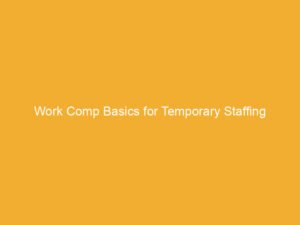
Workers’ Comp Coverage Options—GA Employment Agency
August 13, 2025
Predictive Modeling: The Future of Workers Comp Claim Prevention
August 13, 2025In the dynamic landscape of temporary staffing, understanding the fundamentals of workers’ compensation is essential for both staffing agencies and their clients. Navigating work comp requirements ensures compliance, mitigates financial risk, and promotes a safer, more productive workforce. This article explores the core principles of workers’ compensation as thay pertain to temporary staffing, offering actionable insights to help industry professionals manage claims effectively and maintain operational resilience.
Table of Contents
- Understanding work Comp Liability in Temporary Staffing
- Key Risk Management Strategies for Temporary Staffing Agencies
- Compliance and Documentation Best Practices for Work Comp
- Optimizing Claims Handling and return to Work Programs
- Q&A
- in Conclusion
Understanding Work Comp Liability in Temporary Staffing
Temporary staffing agencies face unique challenges when it comes to workers’ compensation liability. Unlike traditional employers, these agencies must carefully navigate the complexities of coverage for employees who work across multiple client sites, frequently enough performing varying job duties. Liability can shift depending on the contractual agreements between the staffing agency and the host employer, making it essential to clearly define roles and responsibilities in the contract. Ensuring that all temporary employees are properly classified and that adequate coverage is secured protects the agency from potentially costly claims and legal disputes.
Key points to consider include:
- Joint Liability: In certain specific cases, both the staffing agency and the host employer may share responsibility for workers’ compensation claims.
- Coverage Customization: Policies can be tailored to reflect the diverse job functions and risk levels associated with temporary placements.
- claims Management: Effective communication and documentation between agencies and clients streamline the claims process and reduce delays.
| Aspect | Staffing Agency Role | Host Employer Role |
|---|---|---|
| Policy Procurement | Primary insurer for temporary workers | May supplement or carry secondary coverage |
| Employee Classification | Defines roles and risk categories | Provides job descriptions and habitat details |
| Incident Reporting | Initiates claim; coordinates with workers | Reports workplace incidents promptly |
Key Risk Management Strategies for Temporary Staffing Agencies
Effective risk management for temporary staffing agencies hinges on implementing proactive measures that address the unique challenges of a transient workforce. Agencies must prioritize thorough employee screening and comprehensive training programs that emphasize workplace safety standards tailored to diverse client environments. Additionally,maintaining clear communication channels between agency staff,temporary workers,and client employers ensures all parties are aligned on safety protocols and incident reporting procedures. Robust documentation and regular audits of safety practices can dramatically reduce the likelihood and impact of workers’ compensation claims.
another cornerstone is establishing a dynamic approach to insurance management. Agencies should work closely with insurers to customize policies that reflect the fluctuating risk profiles associated with different assignments and industries. Utilizing technology-driven tools for incident tracking and claims management not only streamlines processes but also provides actionable insights into emerging risk trends.Below is a concise overview of key strategic elements for risk mitigation:
| Strategy | Benefit | Implementation Tip |
|---|---|---|
| Pre-Placement Risk Assessment | Identifies potential hazards early | Customize assessments by industry |
| Targeted Safety training | Enhances worker preparedness | Use interactive, scenario-based learning |
| Claims Monitoring & Reporting | Improves response time | Leverage automated reporting tools |
| policy Customization with Insurers | Aligns coverage with real risks | Review policy quarterly |
| Stakeholder Communication Plan | Ensures clarity and accountability | Schedule regular multi-party meetings |
- Continuous Improvement: regularly revisit and refine safety protocols based on claim data and workforce feedback to stay ahead of evolving risks.
- Legal Compliance: Stay updated on local and federal regulations impacting temporary staffing and workers’ compensation to minimize legal exposure.
Compliance and Documentation Best Practices for Work Comp
Adhering to compliance standards and maintaining thorough documentation are essential for managing workers’ compensation effectively within temporary staffing environments. Employers must ensure that they have clear protocols in place to capture all necessary injury information promptly and accurately. This includes incident reports, medical documentation, and communication logs with employees and healthcare providers. Leveraging digital documentation tools can considerably reduce errors and streamline the claims process, helping to mitigate the risk of non-compliance penalties.
Implementing best practices often involves creating a centralized repository for workers’ compensation records, combined with routine internal audits to verify data integrity. Additionally, organizations should focus on training for both HR personnel and supervisors to recognize reportable injuries early and understand state-specific regulatory requirements. The table below highlights key compliance components and their practical request within a temporary staffing context:
| Compliance Component | Best Practice | Benefit |
|---|---|---|
| Injury Reporting | Immediate electronic reporting within 24 hours | Ensures timely claims processing |
| Documentation Accuracy | Standardized forms and checklists | Reduces errors and omissions |
| training | Regular workshops on state regulations | Improves compliance adherence |
| Record Retention | Secure, centralized digital storage | Facilitates audits and legal readiness |
Optimizing Claims Handling and Return to Work Programs
Efficient handling of workers’ compensation claims is essential to controlling costs and maintaining operational productivity in temporary staffing environments. Establishing a clear, prompt claims reporting process helps to mitigate the duration and expense of compensation cases. Key practices include immediate incident documentation,assigning dedicated claims coordinators,and using technology platforms for real-time communication between injured workers,healthcare providers,and insurance carriers. These steps ensure claims progress swiftly and reduce the risk of complications or prolonged absenteeism.
Return to work (RTW) programs are equally critical, as they facilitate safe and timely reintegration of temporary staff following an injury. Successful RTW strategies focus on modified duties and collaborative planning with client employers to accommodate physical limitations while maintaining productivity. Implementing the following elements can improve RTW outcomes:
- Detailed medical assessments and tailored work modifications
- Ongoing case management with clear milestones and feedback loops
- Employee engagement and education to reduce fear and absenteeism
- Consistent communication between staffing agency, client, and injured worker
| Key Metric | Before Optimization | after Optimization |
|---|---|---|
| Average Claim Duration | 90 days | 45 days |
| Return to Work Rate | 60% | 85% |
| Claims Cost Reduction | – | 30% |
Q&A
Q&A: Work Comp Basics for temporary Staffing
Q1: What is Workers’ Compensation and why is it important for temporary staffing?
A1: Workers’ Compensation (Work Comp) is a form of insurance that provides wage replacement and medical benefits to employees injured during the course of employment. For temporary staffing agencies, Work Comp is critical as it protects both the agency and client companies from liability and ensures that temporary employees receive the necessary care and benefits if injured.
Q2: who is responsible for providing Workers’ Compensation coverage in temporary staffing arrangements?
A2: Typically, the temporary staffing agency is the statutory employer responsible for providing Workers’ Compensation coverage for the temporary employees they place. The agency must ensure compliance with applicable laws and policies irrespective of the client company’s coverage.
Q3: How does Workers’ Compensation insurance differ for temporary workers compared to permanent employees?
A3: while the essential benefits are similar, temporary staffing agencies often face unique challenges such as varying job sites, diverse risk exposures, and fluctuating workforce sizes. This often leads to specialized Work Comp policies that take into account different occupational hazards and ensure coverage across multiple client sites.Q4: What are key risk management strategies for staffing firms regarding Work Comp?
A4: Effective risk management includes conducting thorough job hazard analyses, providing safety training to temporary employees, maintaining clear communication with client companies, and verifying that the Work Comp policy is adequately tailored to cover the specific nature of temporary assignments.
Q5: How can temporary staffing agencies manage premium costs related to Workers’ Compensation?
A5: Agencies can manage premiums through accurate job classification, proactive injury prevention programs, timely reporting, and maintaining low claim frequency. Building a strong safety culture and collaborating with clients to minimize workplace risks also contribute to cost control.
Q6: What should client companies know about Workers’ Compensation coverage for temps they hire?
A6: Client companies should understand that the temporary staffing agency generally carries the Workers’ Compensation coverage for temps. Though, clients must ensure that the agency provides proof of insurance and that roles assigned are accurately communicated to avoid coverage gaps or disputes.
Q7: Are there any legal considerations unique to Workers’ Compensation in temporary staffing?
A7: Yes. Legal considerations include determining the employment relationship,compliance with state-specific Work Comp laws,handling claims jurisdiction,and navigating potential co-employer liability issues. Staffing agencies must stay informed about evolving regulations to maintain compliant and effective coverage.
Q8: What steps should staffing firms take in the event of a Workers’ Compensation claim?
A8: Upon a claim, staffing firms should promptly report the injury to their insurer, coordinate with the client company for information gathering, provide support to the injured worker, and implement corrective measures to prevent future incidents. Proper documentation and timely communication are essential throughout the claims process.
This Q&A provides a foundational understanding of Workers’ Compensation as it applies to temporary staffing, highlighting responsibilities, challenges, and best practices essential for risk mitigation and compliance in this specialised sector.
In Conclusion
understanding the fundamentals of workers’ compensation within the context of temporary staffing is essential for both staffing agencies and their client companies. By proactively managing workers’ comp responsibilities, ensuring clear communication, and maintaining compliance with applicable laws, organizations can mitigate risks and protect the well-being of temporary workers. Establishing robust processes not only safeguards all parties involved but also contributes to a more efficient and trustworthy staffing relationship. As the temporary workforce continues to grow, staying informed and prepared remains a critical component of successful workforce management.
“This content was generated with the assistance of artificial intelligence. While we strive for accuracy, AI-generated content may not always reflect the most current information or professional advice. Users are encouraged to independently verify critical information and, where appropriate, consult with qualified professionals, lawyers, state statutes and regulations & NCCI rules & manuals before making decisions based on this content.

